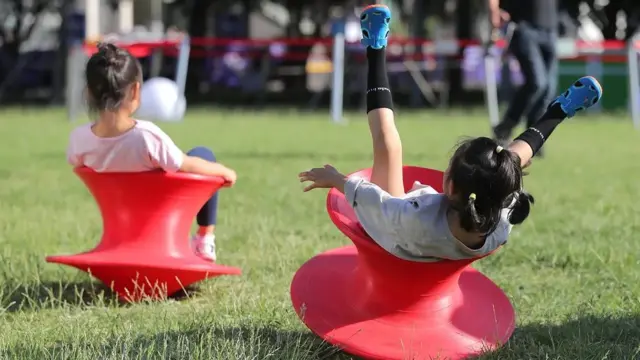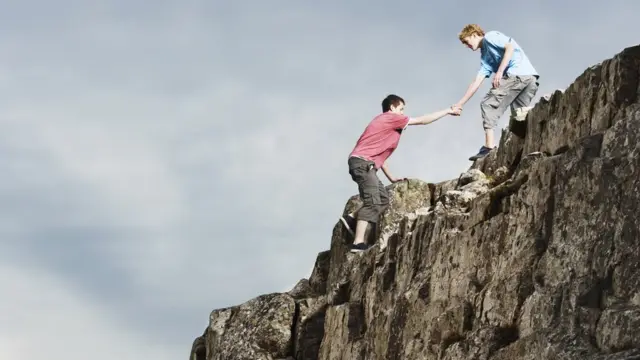
How to teach children (and learn yourself) to deal with risks
When you’re in charge of a small child, even the most idyllic environment can become a danger zone.
In the early years, there is a risk of being hit by a car, falling into a swimming pool, or being bitten by a dog (most commonly, the family dog).
Potential dangers change with age: alcohol, drugs, violence, and untreated mental health problems can jeopardize the well-being of teens and young adults.
Road traffic injuries also remain a major risk. And then there are invisible hazards, such as air pollution, which are especially difficult to detect and address.
Eventually, we all need to be able to assess risk for ourselves, to navigate the world safely without the guidance of our parents or guardians.
Without those skills, we are much more likely to make rash decisions that can result in poor health, financial problems, and even a criminal record.
How do children learn these lessons? And what can parents and guardians do to steer their children down a safer path in the world – and perhaps learn a few tricks for themselves, too?
With a growing body of literature devoted to the psychology of risk, we can finally answer these questions.
Now, psychologists have identified why children often fail to spot basic dangers, the reasons why teenagers seem to bet their future on a moment of excitement, and the educational barriers that can prevent people from learning, even as adults, to rationally assess risks.

Image source,Getty Images
Each stage of development will require a different approach. But with the right guidance, it is possible to teach children and adolescents to develop high “decision-making competence,” with enormous consequences for the rest of their lives.
“These skills that underlie our destiny can be taught,” says Joshua Weller, a psychologist at the University of Leeds in the United Kingdom who specializes in risk. “They can be nurtured and developed through many different methods.”
Insufficient knowledge
Babies are born with surprisingly little innate knowledge about even the most basic dangers.
As many parents will know from frightening experiences, babies who are learning to crawl for the first time will try to pull themselves off the edge of the bed or changing table without a moment’s hesitation. Studies suggest that fear of heights only comes from experience, as the child learns to pay closer attention to their peripheral vision.
As social sponges, young children learn to recognise danger indirectly , by observing the facial expressions and body language of others. Chris Askew of the University of Surrey, UK, for example, showed 8-year-olds photographs of three unfamiliar marsupials, which were paired with either a photo of a scared face, a photo of a smiling face, or no photo at all.
In follow-up tests, they reported feeling more frightened by the animals that had been paired with the frightened faces and were much more reluctant to open a box supposedly containing the animal in question.
And the effects were long-lasting, with further testing revealing that they were more likely to associate fear-related words with those animals for months after the original exposure.
Integration of the senses
However, recognising danger is not enough to keep a child safe, as their developing brain may not be quick enough to react to the problem at hand. Research shows that we do not learn to fully integrate our senses, such as sight and hearing, until we are around 10 years old.

Image source,Getty Images
Young children only gradually develop a sense of risk and danger. This makes it difficult, for example, to recognise the speed at which a car is approaching, for example.
Young children’s developing brains also tend to be more easily distracted, meaning they may simply forget about potential danger.
When it comes to things like road safety, parents are often advised to establish routines, such as always looking left and right several times before crossing or waiting for the green man to appear at a traffic light.
Repeated practice will make these behaviors habitual, so that the child will eventually perform them without constant reminders.
Increasing rationality
Guiding young people through adolescence presents its own challenges. The adolescent brain is known to undergo major structural changes , which appear to increase the sensitivity of its dopamine signaling, a neurotransmitter associated with pleasure.
It was once thought that this made teenagers much more impulsive than younger children, as they actively seek out risky situations that might give them a bigger hit of dopamine.
However, laboratory experiments that have attempted to examine the cognitive processes involved in risk assessment suggest that this is not the case. These studies often take the form of games.

Image source,Getty Images
They might be given a multi-coloured roulette wheel with an arrow in the middle, for example. If the wheel lands on the right colour, they have a chance of winning $10, but there is a 50% chance of winning nothing. Or they could opt for a smaller but guaranteed payout of $5.
Contrary to expectations, these studies show that teenagers tend to be more cautious , opting more often for small sums of guaranteed income, compared to their younger peers.
“When we give adolescents the opportunity to avoid risks, they actually choose the safe option more often than boys do,” says Ivy Defoe, an assistant professor in the department of child development and education at the University of Amsterdam in the Netherlands.
From these results, Defoe concludes that teenagers are not necessarily programmed to rebel. Often, it is simply a matter of the situations they find themselves in.
As they gain independence away from the watchful eyes of their parents, there are many more opportunities to act rashly, whether it’s trying to shoplift, try an illegal drug, join a gang, have unprotected sex, or race their friends on the highway.
“Access to risk-prone situations increases dramatically during adolescence and emerging adulthood,” Defoe explains, and sometimes it’s hard to resist the temptations they bring.
Ability to reason
When trying to help a teenager navigate their newfound freedom, it’s worth remembering that there are considerable differences in risk assessment between individuals of any age.
There is a great deal of variation in how people perform on laboratory gaming tasks, for example.

Image source,Getty Images
So while on average teenagers may not be drawn to danger, a sizable proportion may frequently throw caution to the winds.
In many cases, this may be the result of a lack of reasoning skills . To investigate this possibility, psychologists have also developed a more comprehensive test of “decision-making competence” (DMC).
This includes questions that assess someone’s abilities to follow basic logical rules when weighing the pros and cons of different options, as well as measures of common cognitive biases that might skew someone’s understanding of risk. For example, it presents participants with two separate statements about condoms. One reads:
Imagine that a type of condom has a 5% failure rate. That is, if you have sex with someone who has the HIV virus, there is a 5% chance that this type of condom will not prevent you from being exposed to the virus.
The other says:
Imagine that a type of condom has a 95% success rate. That is, if you have sex with someone who has the HIV virus, there is a 95% chance that this type of condom will prevent you from being exposed to the HIV virus.
The two statements would be presented separately, in different sections of the test, and in each case, participants must evaluate whether condoms are a successful way of reducing the risk of infection.
Each of these statements expresses the same risk information , but many people point out that the condoms in the first example are ineffective, while they say that the ones in the second are effective. This is known as the “framing bias.”
If you show this kind of inconsistency in your answers, it indicates that you may not be used to evaluating statistical information critically and focusing on the specific details of what is being presented; instead, you simply understand the information based on the way it is presented, which can be misleading.
Logical thinking
Other questions test the consistency of people’s risk perception.
Participants may be asked to guess their chances of dying within the next year or within the next 10 years. Logically, the probability given for the first question should be lower than the second, as the risk of dying accumulates over time, but not all answers reflect this.

Image source,Getty Images
Again, this may reflect a general inability to think logically about probabilities.
Finally, participants are asked about their general knowledge of common risks and their confidence in their answers. Someone who is irrationally confident in their knowledge will receive a lower score. This is important, as it is often our failure to judge our own abilities that puts us in the most dangerous situations.
All of these questions may sound fairly academic, but people’s performance on the decision-making competence scale has, in psychological jargon, “ecological validity.” “It predicts a lot of outcomes in the future,” explains Weller, who has conducted many of these studies.
When the decision-making competency test was administered to adolescents, for example, those who scored low tended to have higher drug use and displayed more delinquent behaviors, such as regularly breaking rules at school.
Meanwhile, when tested on adults, it appears to predict everything from missing a flight to contracting a sexually transmitted disease or declaring bankruptcy. Importantly, this is largely independent of their IQ.
Decision-making competence is not just a measure of raw intellectual ability, but specifically how well someone is able to assess situations.
Learning to think
Both Defoe’s and Weller’s research suggest that parents and teachers may need a sophisticated approach to guiding pre-teens and teens through life’s risks. Rather than simply imposing strict rules that eliminate a child’s exposure to risk, it might be more useful, in the long run, to help him hone his thinking and decision-making skills.

Image source,Getty Images
Perhaps most important is to foster self-control and emotional regulation , since so many dangers are the result of impulsivity. Practices such as mindfulness can be helpful, as can metacognitive practices, such as teaching children to imagine the consequences of their actions.
Along the way, parents can encourage the use of critical thinking, strategies such as looking for evidence that contradicts their assumptions. Schools can also help children and young people learn to make better decisions.
In a 10th grade essay in Oregon, USA, history teachers and students examined historical events in terms of the decisions historical figures faced, for example, taking on the role of steelworkers deciding whether to strike for higher wages.
The study found that the approach increased students’ academic performance as well as their scores on the decision-making competency test.
Weller stresses the need for a multi-pronged approach. “I don’t think there’s just one thing that needs to be prescribed,” she says. The goal is to use every means possible to get children and adolescents to start thinking about risk and danger in a more analytical way.
By the time they reach adulthood, they should be prepared to deal more rationally with life’s dangers and eventually use those skills to protect their own children as well.







1 thought on “How to teach children (and learn yourself) to deal with risks”